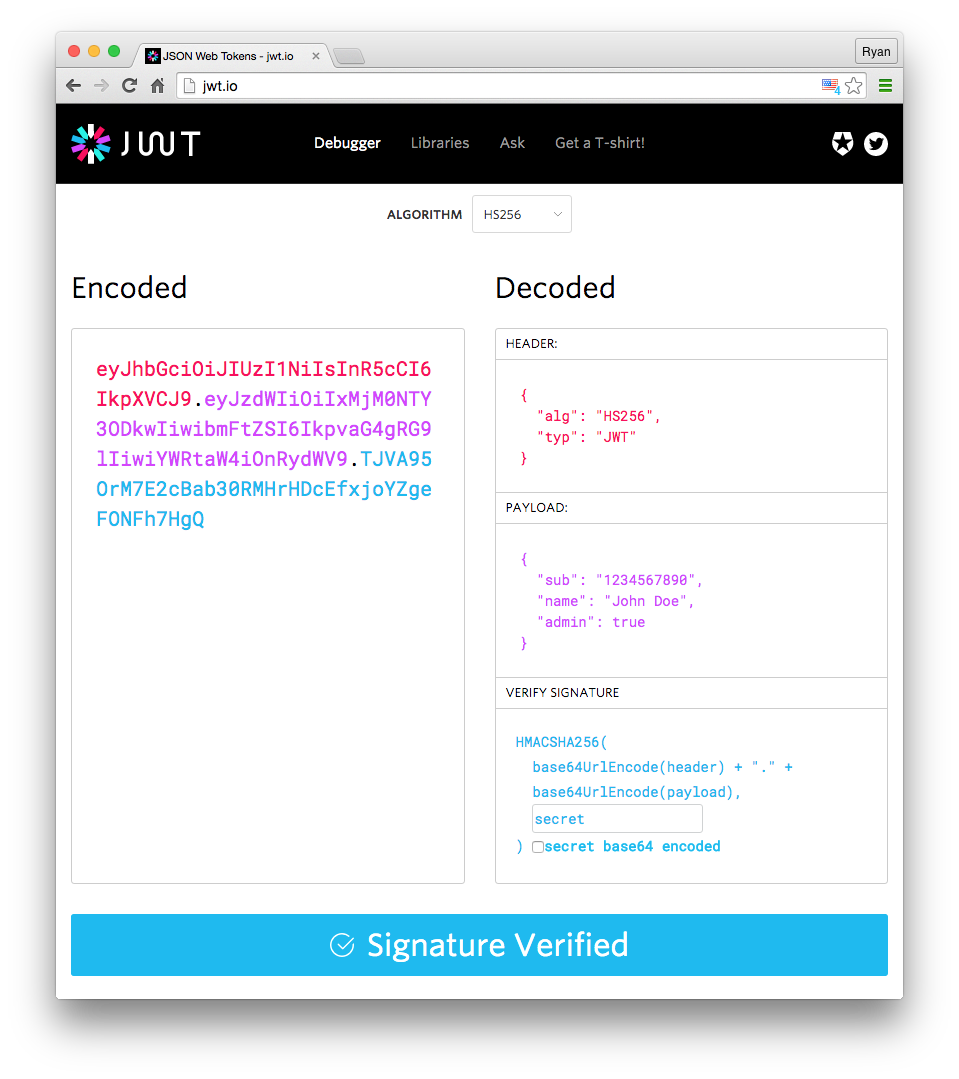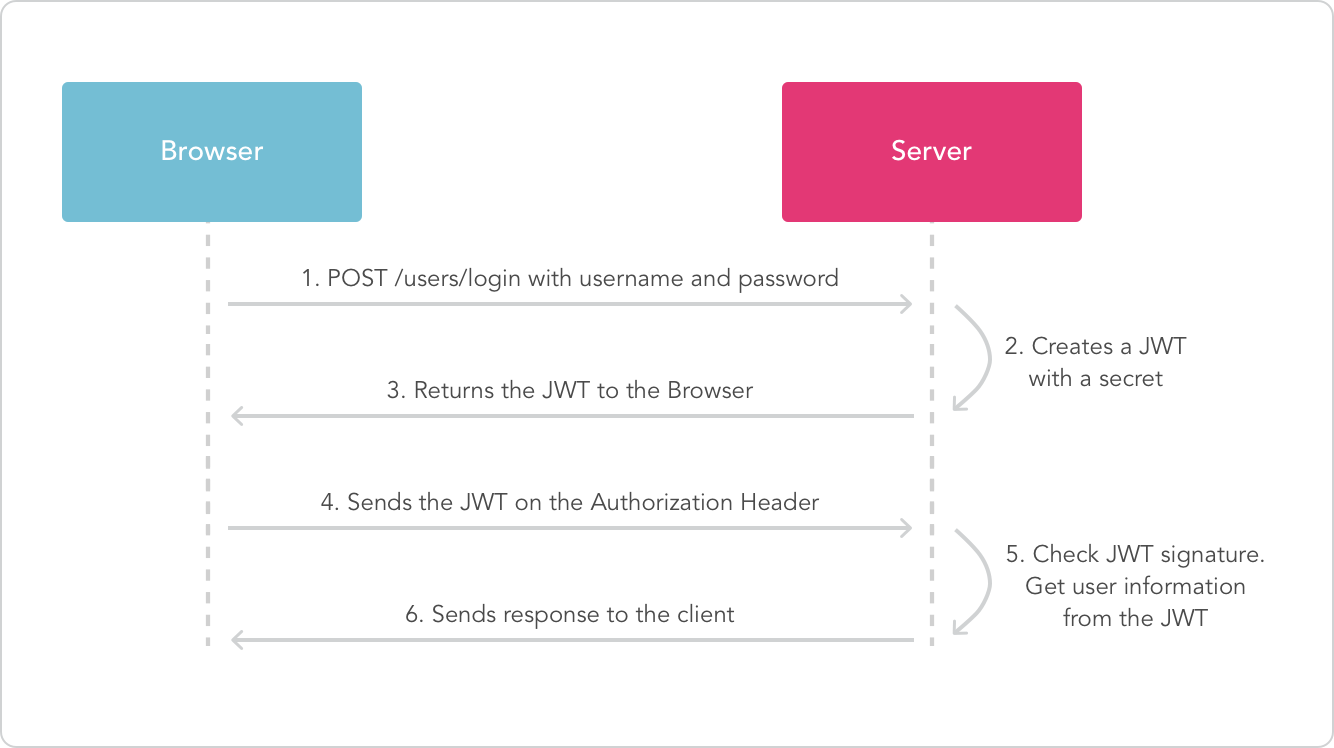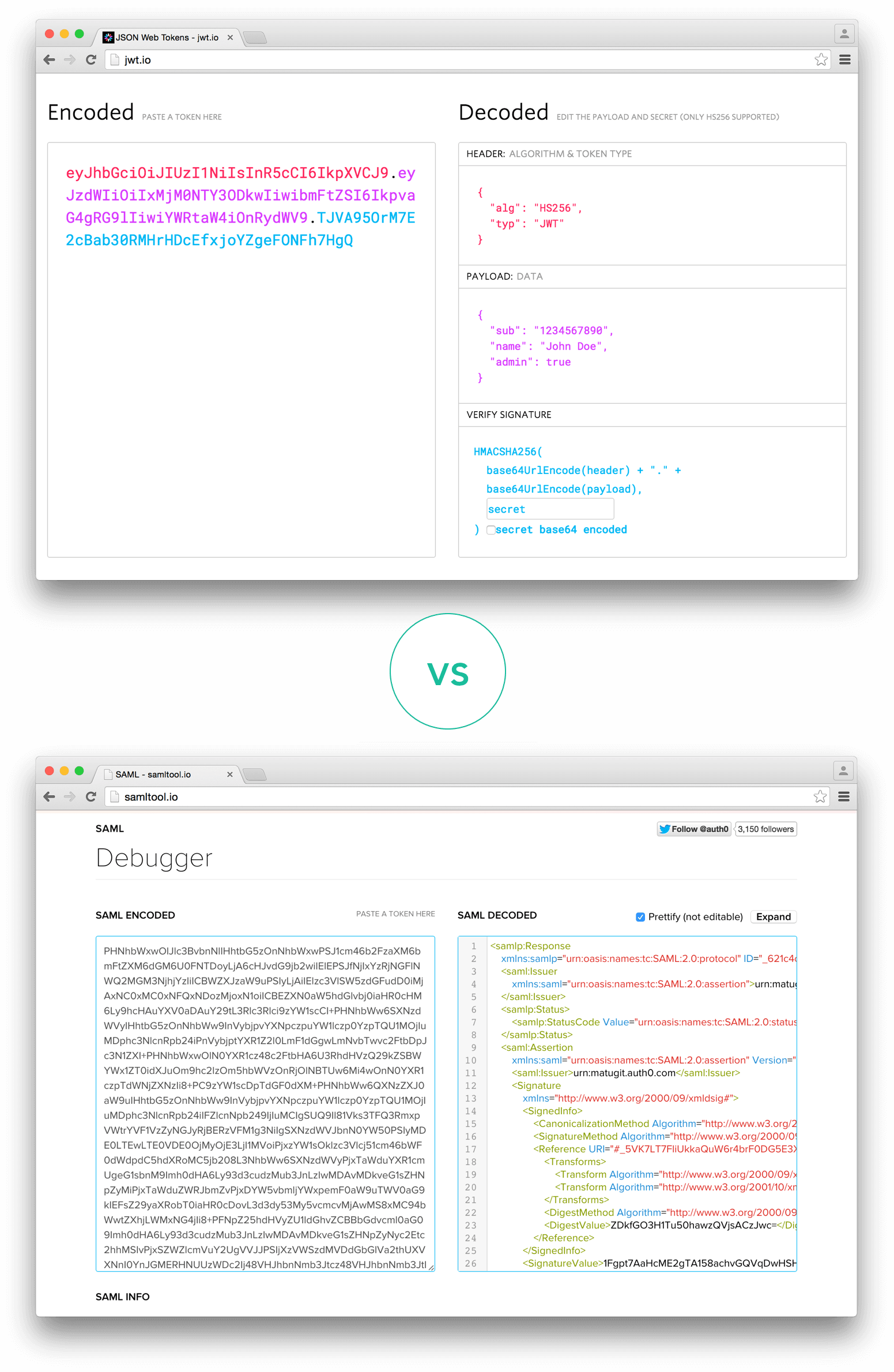Introduction to JSON Web Tokens
来源:互联网 发布:java mysql 编辑:程序博客网 时间:2024/06/14 01:24
https://jwt.io/introduction/
What is JSON Web Token?
JSON Web Token (JWT) is an open standard (RFC 7519) that defines a compact and self-contained way for securely transmitting information between parties as a JSON object. This information can be verified and trusted because it is digitally signed. JWTs can be signed using a secret (with the HMAC algorithm) or a public/private key pair using RSA.
Let's explain some concepts of this definition further.
Compact: Because of its smaller size, JWTs can be sent through an URL, POST parameter, or inside an HTTP header. Additionally, the smaller size means transmission is fast.
Self-contained: The payload contains all the required information about the user, avoiding the need to query the database more than once.
When should you use JSON Web Tokens?
Here are some scenarios where JSON Web Tokens are useful:
Authentication: This is the most common scenario for using JWT. Once the user is logged in, each subsequent request will include the JWT, allowing the user to access routes, services, and resources that are permitted with that token. Single Sign On is a feature that widely uses JWT nowadays, because of its small overhead and its ability to be easily used across different domains.
Information Exchange: JSON Web Tokens are a good way of securely transmitting information between parties, because as they can be signed, for example using public/private key pairs, you can be sure that the senders are who they say they are. Additionally, as the signature is calculated using the header and the payload, you can also verify that the content hasn't been tampered with.
What is the JSON Web Token structure?
JSON Web Tokens consist of three parts separated by dots (.), which are:
- Header
- Payload
- Signature
Therefore, a JWT typically looks like the following.
xxxxx.yyyyy.zzzzz
Let's break down the different parts.
Header
The header typically consists of two parts: the type of the token, which is JWT, and the hashing algorithm being used, such as HMAC SHA256 or RSA.
For example:
1234{ "alg": "HS256", "typ": "JWT"}
Then, this JSON is Base64Url encoded to form the first part of the JWT.
Payload
The second part of the token is the payload, which contains the claims. Claims are statements about an entity (typically, the user) and additional metadata. There are three types of claims: reserved, public, and privateclaims.
Reserved claims: These is a set of predefined claims which are not mandatory but recommended, to provide a set of useful, interoperable claims. Some of them are: iss (issuer), exp (expiration time), sub(subject), aud (audience), and others.
Notice that the claim names are only three characters long as JWT is meant to be compact.
Public claims: These can be defined at will by those using JWTs. But to avoid collisions they should be defined in the IANA JSON Web Token Registry or be defined as a URI that contains a collision resistant namespace.
Private claims: These are the custom claims created to share information between parties that agree on using them.
An example of payload could be:
12345{ "sub": "1234567890", "name": "John Doe", "admin": true}
The payload is then Base64Url encoded to form the second part of the JSON Web Token.
Signature
To create the signature part you have to take the encoded header, the encoded payload, a secret, the algorithm specified in the header, and sign that.
For example if you want to use the HMAC SHA256 algorithm, the signature will be created in the following way:
1234HMACSHA256( base64UrlEncode(header) + "." + base64UrlEncode(payload), secret)
The signature is used to verify that the sender of the JWT is who it says it is and to ensure that the message wasn't changed along the way.
Putting all together
The output is three Base64 strings separated by dots that can be easily passed in HTML and HTTP environments, while being more compact when compared to XML-based standards such as SAML.
The following shows a JWT that has the previous header and payload encoded, and it is signed with a secret. 
If you want to play with JWT and put these concepts into practice, you can use jwt.io Debugger to decode, verify, and generate JWTs.

How do JSON Web Tokens work?
In authentication, when the user successfully logs in using his credentials, a JSON Web Token will be returned and must be saved locally (typically in local storage, but cookies can be also used), instead of the traditional approach of creating a session in the server and returning a cookie.
Whenever the user wants to access a protected route or resource, the user agent should send the JWT, typically in the Authorization header using theBearer schema. The content of the header should look like the following:
Authorization: Bearer <token>This is a stateless authentication mechanism as the user state is never saved in server memory. The server's protected routes will check for a valid JWT in the Authorization header, and if it's present, the user will be allowed to access protected resources. As JWTs are self-contained, all the necessary information is there, reducing the need to query the database multiple times.
This allows you to fully rely on data APIs that are stateless and even make requests to downstream services. It doesn't matter which domains are serving your APIs, so Cross-Origin Resource Sharing (CORS) won't be an issue as it doesn't use cookies.
The following diagram shows this process:

Why should we use JSON Web Tokens?
Let's talk about the benefits of JSON Web Tokens (JWT) when compared toSimple Web Tokens (SWT) and Security Assertion Markup Language Tokens (SAML).
As JSON is less verbose than XML, when it is encoded its size is also smaller, making JWT more compact than SAML. This makes JWT a good choice to be passed in HTML and HTTP environments.
Security-wise, SWT can only be symmetricly signed by a shared secret using the HMAC algorithm. However, JWT and SAML tokens can use a public/private key pair in the form of a X.509 certificate for signing. Signing XML with XML Digital Signature without introducing obscure security holes is very difficult when compared to the simplicity of signing JSON.
JSON parsers are common in most programming languages because they map directly to objects. Conversely, XML doesn't have a natural document-to-object mapping. This makes it easier to work with JWT than SAML assertions.
Regarding usage, JWT is used at Internet scale. This highlights the ease of client-side processing of the JSON Web token on multiple platforms, especially mobile.
 Comparison of the length of an encoded JWT and an encoded SAML
Comparison of the length of an encoded JWT and an encoded SAML
If you want to read more about JSON Web Tokens and even start using them to perform authentication in your own applications, browse to the JSON Web Token landing page at Auth0.
- Introduction to JSON Web Tokens
- JSON-WEB-TOKENS
- JSON Web Tokens 简介
- JSON Web Tokens介绍
- JSON Web Tokens
- JSON Web Tokens(JWT)介绍
- 系统安全-JWT(JSON Web Tokens)
- JWT(JSON Web Tokens)的使用
- JSON Web Tokens的实现原理
- 在Nodejs中使用JSON WEB Tokens
- An introduction to JSON
- Introduction to JSON
- Introduction to Web Services
- 微服务架构中的身份验证问题 :JSON Web Tokens( JWT)
- 使用JSON-WEB-TOKENS方式认证用户登录
- JWT(JSON Web Tokens)在Spring 微服务中的应用
- JWT(JSON WEB TOKENS)-一种无状态的认证机制
- 基于JSON Web Tokens的单点登录(SSO)或通行证(Passport)系统方案
- Swift-if语句
- JS笔记:原型
- 算法学习之尺取法
- JSP 的OUT对象输出
- 最大Xor路径 7.30 T2
- Introduction to JSON Web Tokens
- 网络工程1.9——七层模型之三网络层
- java 大数加法
- android之<include>和<ViewStub>标签的区别
- python 矩阵运算
- hdu-1251统计难题-字典树的简单应用
- MIDI文件(2)
- 更改工程(项目)名称,对话框资源ID、类名,控件ID、变量名、类名
- 设计模式之状态模式


